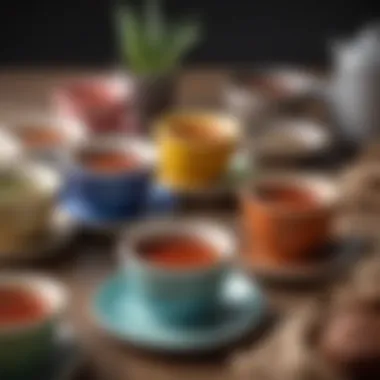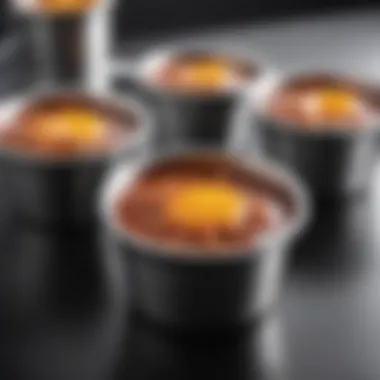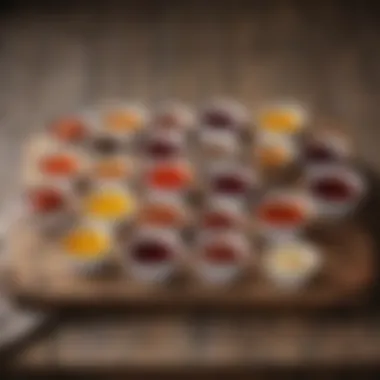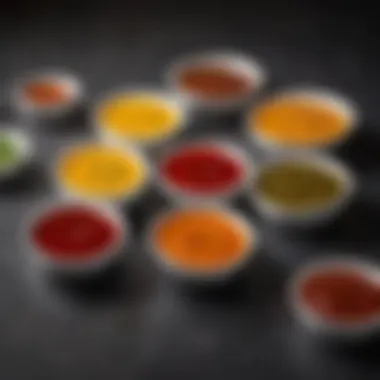Exploring the Importance of Sauce Cups at Walmart


Intro
In the realm of culinary arts, small items can have a major impact. Among them, sauce cups stand out. Available at Walmart, these cups are often overlooked. Yet, they hold tremendous versatility and significance in both casual and formal dining contexts. This article will explore their design, functionality, and the various roles they play in enhancing not just the dish, but the entire dining experience.
Sauce cups serve several purposes. They contain sauces, dressings, or dips, which can elevate a meal. Cooks can utilize them for both preparation and presentation. Understanding the variety of materials and sizes can help consumers make informed choices. This discussion goes beyond just appearance; it encompasses utility and organization. Well-chosen sauce cups can simplify serving and improve the overall table aesthetics, whether it is a family dinner or a festive gathering.
Let's delve deeper into these essential items.
Prelude to Sauce Cups
In culinary practice, sauce cups play a significant role. They serve as practical tools for serving sauces, dipping elements, and condiments, adding structure to any meal. At Walmart, these tools are widely available, reflecting their importance in both home and professional kitchens.
Sauce cups come in various sizes and materials, each offering unique advantages. Their versatility contributes to better portion control and enhances the aesthetic of food presentation. Additionally, these cups are designed to hold various types of liquids, accommodating different culinary needs. The diverse options available at Walmart make it easy for consumers to find sauce cups that best suit their preferences and usage occasions.
Defining Sauce Cups
Sauce cups are small dishes, typically made to hold sauces like ketchup, barbecue, or soy sauce. They often come in varying sizes and shapes. The material can range from plastic to glass or ceramic. Their design allows for easy dipping, pouring, or spooning of condiments onto platters or directly onto food. They are an essential utensil in both casual and formal dining.
Historical Context
The use of sauce cups dates back centuries. Historically, these containers were made from clay and later evolved into glass and metal designs. They reflect the culinary traditions of different cultures, serving as an important aspect of dining customs. For instance, in Chinese cuisine, small cups for sauces can be commonly found at dining tables, signifying their longstanding relevance in food culture. This rich history underscores the enduring significance of sauce cups in global culinary practices.
Types of Sauce Cups Available at Walmart
Understanding the varieties of sauce cups available at Walmart is essential for any culinary enthusiast. These cups offer not just functional utility but also enhance the overall dining experience. Choosing the right sauce cup can change how flavors are served and perceived. Thus, exploring various types of sauce cups helps clarify the best choices for different culinary applications.
Material Variations
Different materials lend themselves to unique characteristics in sauce cups. Factors like durability, ease of cleaning, and aesthetic appeal vary significantly based on the material chosen.
Plastic Options
Plastic sauce cups are lightweight and often shatterproof. This makes them a favorable choice for outdoor gatherings and casual meals. They are typically less expensive, which encourages bulk purchasing. A key characteristic is their versatility—they come in various colors and designs. On the downside, they might not offer the same upscale presentation as glass or ceramic options. Additionally, prolonged exposure to high heat can warp some plastic varieties.
Glass Designs
Glass sauce cups offer an elegant presentation. Their transparency showcases the sauce or condiment, which can enhance the visual appeal of the dish. They are easy to clean and often microwave and dishwasher safe, adding convenience. However, glass can be fragile, making it less ideal for events where breakage is a concern. Their aesthetic quality makes them popular for formal settings or when entertaining guests.
Ceramic Choices
Ceramic sauce cups are known for their artistry. They can be found in various colors and patterns, making them appealing for home decor as well. Besides aesthetic appeal, ceramics have excellent heat retention properties. Nonetheless, ceramics can be fragile and heavy, limiting their use in some situations. A unique feature is that they can often be customized, allowing for personal touches in dining affairs.
Stainless Steel Alternatives
Stainless steel sauce cups are highly durable and resistant to rusting or corrosion. They are often chosen for their sleek look and modern aesthetic. A notable advantage is their ability to maintain temperatures, making them suitable for serving hot sauces. However, stainless steel lacks the transparency of glass, which may detract from visual presentation. They can be heavier than other materials, which might limit their use in certain settings.
Size and Capacity
The size of sauce cups plays a crucial role in their functionality. Various sizes cater to different needs, whether for individual servings or larger portions during gatherings.
Small Portions
Small sauce cups are perfect for condiments or dipping sauces. Their compact size allows for easy handling and minimizes waste. A key benefit is that they can be used to control the amount served, which is particularly advantageous for calorie-conscious diners. However, their smaller capacity may not be adequate for group dining scenarios.
Standard Sizes
Standard-sized sauce cups are versatile and suitable for everyday use. They strike a balance between portion control and serving practicality. Typically, these cups can accommodate most common sauces and are widely available. They are beneficial for regular family meals as well as entertaining. Their size makes them a popular choice among consumers at Walmart.
Larger Serving Cups


Larger serving cups are ideal for gatherings or buffet-style meals where multiple diners will serve themselves. They provide ample space for a variety of sauces and condiments, promoting shared experiences. A unique feature is their ability to reduce the number of containers needed on the table. However, they can take up more space, which might limit their usage in smaller dining areas.
Functional Roles of Sauce Cups in Culinary Use
Sauce cups serve essential functions in both home and professional kitchens. Their design supports various culinary practices that enhance not just flavor, but also the overall dining experience. Understanding the versatile roles of sauce cups can elevate meal presentation and organization.
Serving Sauces and Condiments
Sauce cups are primarily designed to hold sauces and condiments, making them practical for serving diverse culinary delights. At the dining table, they allow for easy access to various sauces like ketchup, ranch, or artisanal salsas. When guests can choose their condiments without cluttering the main dish, it promotes a clean and inviting presentation. This versatility enhances the flavor experience while adding a touch of thoughtfulness to meal serving.
Portion Control
Portion control is crucial in both professional kitchens and home cooking. Using sauce cups helps measure out precise amounts of sauces or dressings. This can prevent excess waste and ensure each dish is balanced in flavor. For instance, a small amount of rich balsamic glaze can transform an ordinary salad without overwhelming it. By discarding the guesswork in serving sizes, cooks can maintain consistency across meals, ensuring guests enjoy flavors as intended.
Enhancing Presentation
Presentation plays a major role in the culinary experience. Sauce cups contribute not just functionally, but also aesthetically. The right design and color of a sauce cup can complement the food it accompanies.
- Color Variety: Brightly colored cups can add vibrancy to the table setting. They can contrast well against monochromatic dishes.
- Materials Matter: A ceramic sauce cup can convey elegance and warmth, while stainless steel might give a more modern, chic appearance.
Sauce cups are not merely vessels; they are elements of design that enhance the dining experience.
In summary, sauce cups in culinary use fulfill multiple roles, from serving sauces and controlling portions to enhancing presentation. They are indispensable tools that every cook should consider, whether in casual family dinners or upscale events.
Walmart’s Sauce Cup Offerings: A Comparison
Walmart stands out as a key player in the retail market, offering a diverse selection of sauce cups tailored to various culinary needs. This section explores the range of options available, with a focus on brand choices and price considerations. Understanding these elements is crucial for consumers who wish to enhance their dining experiences while managing their budgets effectively.
Brand Options at Walmart
Mainstream Brands
Mainstream brands, such as Rubbermaid and Pyrex, contribute significantly to the sauce cup market at Walmart. These brands are well-known for their quality and reliability. A key characteristic of mainstream brands is their broad availability and widespread trust among consumers. For many shoppers, choosing these brands is synonymous with making a safe purchase.
The unique feature of mainstream brands often lies in their extensive product lines that cater to different needs. For example, Rubbermaid's sauce cups are typically designed with airtight seals, making them popular for storage. This feature ensures that sauces and condiments remain fresh for longer periods, addressing a common concern among home cooks. However, the perception of mainstream brands can lead to slightly higher prices, which may be a disadvantage for budget-conscious shoppers.
Local Producers
Local producers present an appealing alternative to mainstream brands available at Walmart. They often highlight a commitment to sustainability and regional craftsmanship. A key characteristic of local producers is their use of eco-friendly materials, appealing to consumers who prioritize environmental considerations in their purchasing decisions.
One unique feature of local producers is their ability to provide niche products that are not readily available from mainstream brands. This can include artisanal designs or unique patterns that add a personal touch to kitchenware. However, a potential disadvantage is that local options may not always have the same level of widespread distribution, which can limit accessibility in some areas.
Price Range Considerations
Price is a critical factor when evaluating sauce cups at Walmart. The offerings span from economical options to premium products, catering to various budget levels. Shoppers can find plastic sauce cups priced as low as a few dollars, while high-end glass or ceramic options may reach significantly higher prices. This range allows consumers to choose based on their specific needs, whether they are seeking daily-use kitchenware or special occasion items.
Usage in Different Culinary Contexts
The role of sauce cups extends beyond mere functionality. They serve pivotal purposes in varied culinary settings, significantly enhancing the dining experience. This section will explore the applications of sauce cups both at home and in professional environments. When used thoughtfully, sauce cups not only elevate meal presentation but also facilitate practical serving methods and portion control.
At Home
Casual Family Meals
Casual family meals often embrace simplicity, and sauce cups contribute effectively to this approach. They allow for easy serving of sauces and condiments, ensuring that everyone at the table can adjust flavors to their liking. This personalized touch transforms a standard meal into a more engaging experience.
The key characteristic of casual family meals is often the relaxed atmosphere. Sauce cups add to this vibe by accommodating various tastes without complicating the meal preparation process. One unique feature of using sauce cups in this setting is their ability to store a variety of sauces in an organized manner. This organization can prevent sauce spills on the table and provide easy access to the condiments. One disadvantage may be the need for extra washing after the meal, but many homemakers find this minor to the benefit of having an organized table setup.
Entertaining Guests


When entertaining guests, presentation becomes especially important. Sauce cups can play a crucial role here. They serve not only to hold sauces but also to enhance the overall aesthetic of the dining table. Eye-catching designs can elevate the visual appeal significantly, making guests feel more welcomed and appreciated.
The key characteristic of entertaining is the focus on experience rather than just meals. Sauce cups can feature bright colors or unique patterns that stimulate conversation among guests. A unique feature is their versatility; they can showcase small portions of various dips or sauces for communal sharing. While this encourages interaction, it might not suit all dining styles, particularly more formal occasions where uniformity is key. Nevertheless, sauce cups remain a popular and effective choice for casual gatherings where enjoyment and interaction are prioritized.
In Professional Settings
Restaurants and Catering
In restaurants and catering, plate presentation is paramount. Sauce cups are often utilized to serve sauces alongside main dishes, enhancing the visual and gastronomic experience. They allow chefs to present sauces in a distinct manner, separating them from the main culinary creation. This separation not only applies to flavor but also to texture and temperature, allowing the diner to experience each component uniquely.
One key characteristic of sauce cups in this context is their capacity to promote portion control. Chefs can craft sauces in measured amounts, ensuring consistency in every dish served. This standardization is essential in professional settings, where customer satisfaction hinges on expected quality. A unique feature is the ability to customize sauce cups according to restaurant branding, adding a signature touch. The disadvantage might involve increased costs, but many establishments view this expense as a worthwhile investment in the overall dining experience.
Culinary Competitions
Culinary competitions often push chefs to think creatively and present their dishes in the most appealing way possible. Sauce cups play an important role here, allowing contestants to showcase their sauces in an organized and attractive manner. In competitions, where aesthetics and innovation are closely scrutinized, the choice of a sauce cup can make a difference.
A key characteristic of culinary competitions is the focus on creativity. Sauce cups provide a unique platform for chefs to convey their artistic expression through sauce presentation. Contestants might opt for unusual shapes, colors, or materials to make their plates stand out. However, a disadvantage might be the time constraint in choosing materials and portions while under pressure. Nevertheless, sauce cups are integral in helping culinary competitors deliver visually stunning and flavorsome results.
Trends in Sauce Cup Design
In recent years, trends in sauce cup design have evolved to encompass various aspects of functionality and aesthetics. The importance of this topic lies in its impact on consumer choices, helping to bridge the gap between practical use and visual appeal. Modern sauce cups are not just vessels for sauces anymore; they serve as an essential element in culinary presentation. As such, exploring these design trends provides insights into consumer preferences and the shifting marketplace.
Eco-Friendly Materials
A growing trend within the sauce cup design landscape is the use of eco-friendly materials. This choice reflects a broader societal shift towards sustainability. Environmentally conscious consumers are increasingly seeking products that are made sustainably. Options like bamboo fiber, recycled plastics, and biodegradable materials have become more prevalent at retailers like Walmart.
Using eco-friendly materials contributes positively to reducing waste and promoting environmental responsibility. These materials often have lesser environmental footprints compared to traditional options. However, manufacturers face challenges in balancing durability with environmental friendliness. Some eco-friendly cups may not withstand the rigors of catering or heavy household use, which could deter some consumers.
Aesthetic Preferences
In addition to materials, aesthetic preferences in sauce cup design continue to influence buyer decisions. Consumers today are not only looking for functionality but also for products that complement their dining decor and enhance overall presentation. Two notable aesthetic trends include minimalism and the use of bright colors.
Minimalism
The minimalism trend emphasizes simplicity and functionality. This design approach is characterized by clean lines and understated elegance. The main contribution of minimalism in sauce cup design is its ability to blend seamlessly into various table settings.
A key characteristic of minimalist sauce cups is their often monochromatic color schemes, which appeal to those who prefer a modern, uncluttered dining experience. Minimalism is a beneficial choice because it aligns with current decor trends, appealing to discerning consumers. The unique feature of minimalistic designs is their versatility. They can fit into both casual and formal dining scenarios. However, some may argue that minimalism can sometimes lack personality.
Bright Colors
Conversely, bright colors have surged in popularity among consumers seeking vibrancy in their dining experiences. This trend brings a sense of fun and life to the table. Brightly colored sauce cups can evoke emotion and excitement during meals.
The key characteristic of this trend is its use of bold hues that stand out against typical dinnerware. Bright colors can make each dining experience feel special and engaging. Their advantage lies in their ability to energize a dining space, making meals more enjoyable. On the downside, they may not suit every aesthetic preference. Not all consumers want bright colors, as some might prefer more subdued or classic designs.
"In the evolving landscape of sauce cup design, balancing functionality and aesthetics is key to attracting modern consumers."
Practical Considerations When Choosing Sauce Cups
When selecting sauce cups, various practical considerations come into play. Understanding these elements can significantly enhance the dining experience. Choices in durability, ease of care, and versatility not only impact usage effectiveness but also the overall satisfaction of food enthusiasts.
Durability and Care
Durability is a fundamental factor. Sauce cups must withstand everyday use without chipping, cracking, or breaking. For example, ceramic cups are known for their sturdiness, while plastic ones may not stand up as well to high heat. Therefore, knowing the material's durability helps in making decisions that suit different environments, like homes or restaurants.
Care of sauce cups also matters. Some materials can go in the dishwasher, while others require hand washing. This aspect can influence a consumer’s choice. Easy maintenance is often a priority for busy individuals. For instance, glass sauce cups can be both aesthetically pleasing and dishwasher-safe, offering a balance of beauty and practicality.
Versatility Beyond Sauces
Sauce cups offer versatility beyond their primary function. They can serve various culinary purposes enhancing their value in the kitchen.


Dessert Serving
Sauce cups can be a contemporary way to serve desserts. They are ideal for puddings, custards, or even ice cream. The small serving sizes allow for portion control which is popular in modern dining settings. Additionally, the visual appeal of layered desserts in these cups adds a touch of elegance to any table.
Key features of dessert serving in sauce cups include:
- Easy Portion Control: Ideal for managing serving sizes.
- Visual Presentation: Engaging way to showcase desserts.
- Adaptable: Suitable for both casual and formal settings.
Individuals looking for trendy ways to present dessert might find sauce cups a beneficial choice by elevating their dining experience. However, some may find the quantity limiting for larger gatherings.
Ingredient Organization
Using sauce cups for ingredient organization is another effective application. In culinary settings, small, well-structured containers help maintain order. They can hold pre-measured spices, sauces, or garnishes, making them accessible and enhancing workflow in the kitchen.
Unique features of using sauce cups for ingredient organization include:
- Space Efficiency: They allow orderly storage in kitchens with limited space.
- Speedy Preparation: Ingredients are easily accessible during cooking.
- Versatility: Useful in both home cooking and professional kitchens.
This method also promotes creativity and experimentation with flavors when preparing meals. Nonetheless, some may find them excessive if not utilized effectively.
Choosing the right sauce cup emphasizes function and convenience, ensuring maximum enjoyment in culinary settings.
Each of these considerations makes the choics around sauce cups more thoughtful and aligned with personal needs.
Consumer Preferences and Buying Trends
Understanding consumer preferences is central to grasping the significance of sauce cups in the market today. Consumers are not simply looking for a container; they seek a product that melds practicality with aesthetic appeal. Given the myriad of choices available at Walmart, the effectiveness of sauce cups in meeting the needs of diverse culinary tasks plays a pivotal role in their buying decisions. Some of the key elements influencing consumer choices include price, material quality, and functionality. Observing these trends helps manufacturers align their offerings with what buyers actually desire.
Sales Data Insights
Sales data shows important trends and preferences among consumers. Reports indicate that plastic sauce cups have gained popularity due to their low cost and convenience. These are lightweight and often disposable, catering particularly well to casual dining settings and events where easy cleanup is a priority. Conversely, glass and ceramic options are attractive for those who prioritize sustainability and a more elegant presentation. The increase in online purchasing also influences sales dynamics. Consumers tend to rely on useful data points, like ratings and reviews, to make informed choices when shopping online.
- Insights from data:
- Plastic cups are typically favored in informal settings.
- Glass selections are rising for home and presentation use.
- Ceramic cups appeal to buyers interested in creative, artisan aesthetics.
The relationship between product attributes and purchasing decisions can shape strategies for suppliers and retailers. This understanding will ultimately lead to improved product offerings that better meet consumer expectations.
Feedback on Popular Products
Feedback from customers provides a wealth of information about sauce cups' effectiveness and desirability. Positive reviews typically highlight several features: durability, ease of cleaning, and design aesthetic. For example, many consumers favor the Anchor Hocking Glass Sauce Cups for their sturdiness and classic look, often mentioning their suitability for both microwave and dishwasher use. Negative feedback can also be telling. Customers express dissatisfaction when products do not meet their expectations in terms of material quality or when they face issues like easily breakable designs.
Some notable takeaways from customer feedback include:
- Durability: Buyers prefer products that withstand frequent use without damage.
- Design: Many appreciate a versatile design that can transition from everyday use to special occasions.
- Size Options: Varied sizes are essential; people want options to suit portion control needs.
"The feedback loop between consumers and manufacturers is vital for enhancing product lines and ensuring satisfaction."
Overall, the interplay of sales data and consumer feedback informs not only the popularity of sauce cups but also encourages ongoing innovations in design and functionality. This synergy positions Walmart, as a main retailer, to respond agilely to market demands.
Epilogue
The conclusion serves as a critical reflection on the entire discourse regarding sauce cups, especially as seen through Walmart’s lens. Recognizing their versatility and significance is vital for both practical use and culinary artistry. Sauce cups are more than just small vessels for condiments; they are essential tools that enhance the experience of cooking and dining. From home cooks looking to organize their kitchen to professional chefs aiming for refined presentation, sauce cups play an integral role.
Summary of Key Insights
Throughout this article, several key insights regarding the role of sauce cups have been highlighted:
- Materials Matter: The diversity of materials such as plastic, glass, ceramic, and stainless steel impacts not just aesthetics but also functionality and durability.
- Functional Roles: Sauce cups serve various functions, including portion control and enhancing visual presentation. Their use goes beyond just sauces, transitioning into dessert servings and ingredient organization.
- Consumer Trends: Insights into consumer preferences and sales data reveal a growing inclination towards more sustainable and aesthetically pleasing designs, indicating a shift in buying behavior.
- Walmart’s Offerings: The range provided by Walmart includes mainstream and local brands at different price points, catering to a wide spectrum of customers.
Future Perspectives
Looking ahead, the future of sauce cups appears promising and dynamic. As culinary trends evolve, so will the design and functionality of these indispensable tools. Expect to see more eco-friendly options as sustainability becomes a central theme in consumer choices. Innovation in materials and designs that prioritize ease of use and cleaning will likely be at the forefront.
Additionally, the integration of smart technology in kitchenware could shape how sauce cups are utilized. Imagine a future where sauce cups could measure portions digitally or remind users of their food safety standards.
In summary, sauce cups are relevant not just in everyday cooking but also in shaping culinary trends. Their importance lies not only in functionality but also in contributing to an organized and appealing dining experience.







